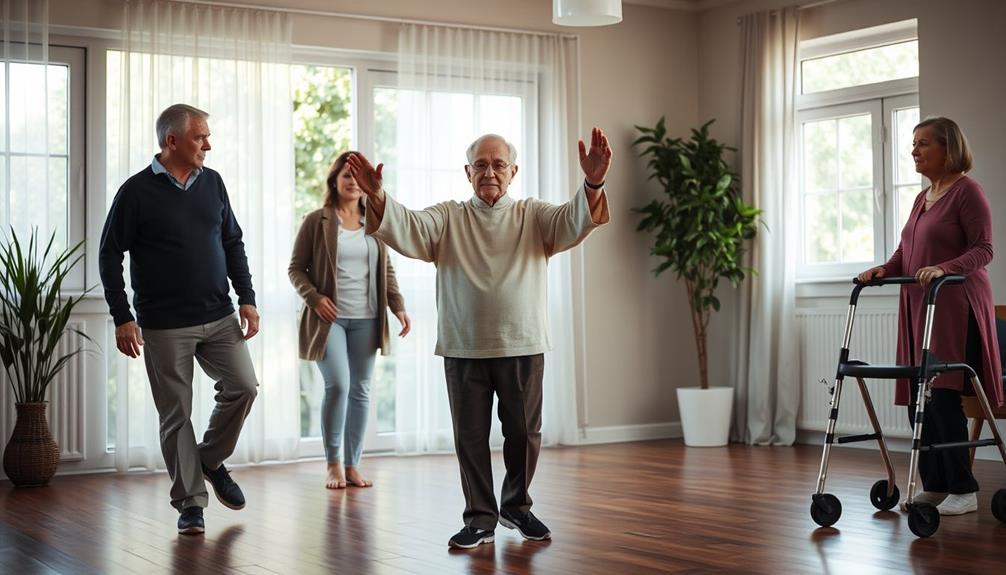If you're dealing with Parkinson's disease, balance issues can really increase your fall risk. To help prevent falls and improve your mobility, regular exercise is key. Aim for strength training a few times a week, and consider dual-task activities to boost your balance. Make some changes at home, like removing tripping hazards and adding grab bars. Stay on top of your medications and discuss any side effects with your doctor, too. Also, practicing safe mobility techniques can make a difference. There's more you can do to enhance your safety and independence, so don't stop here—keep exploring your options!
Key Takeaways
- Regular exercise, including strength training and balance activities, significantly reduces fall rates in individuals with Parkinson's disease.
- Modifying the home environment by removing hazards and installing grab bars enhances safety and stability.
- Proper medication management and regular reviews can minimize side effects that contribute to balance issues.
- Utilizing assistive devices, like walkers and grab bars, provides support and improves mobility while reducing fall risk.
- Professional guidance from healthcare providers ensures tailored assessments and effective use of balance strategies and assistive devices.
Understanding Balance Issues

Balance issues are a common and troubling aspect of Parkinson's disease (PD) that can profoundly impact your daily life. The impairment in balance you experience may lead to an increased risk of falls, which occur at rates double that of age-matched older adults. Key contributors to these balance issues include postural instability and freezing of gait, both of which can greatly disrupt your mobility.
Additionally, individuals with PD may benefit from natural remedies alongside conventional medications to help manage symptoms more effectively.
As PD progresses, you might find it harder to right yourself after being off-balance, making falls more likely. Approximately 60% of individuals with PD experience falls annually, and many suffer multiple falls, which can further complicate medication schedules and exacerbate symptoms.
The combination of postural instability and festinating gait, characterized by short, rapid steps, can create a dangerous cycle that increases your fall risk.
Addressing these balance issues is essential. Engaging in physical therapy can help improve your strength and coordination, while medication adjustments might also play a role in managing your symptoms.
With the right strategies, you can maintain better mobility and reduce the risk of falls, leading to a safer and more fulfilling life.
Identifying Fall Risk Factors
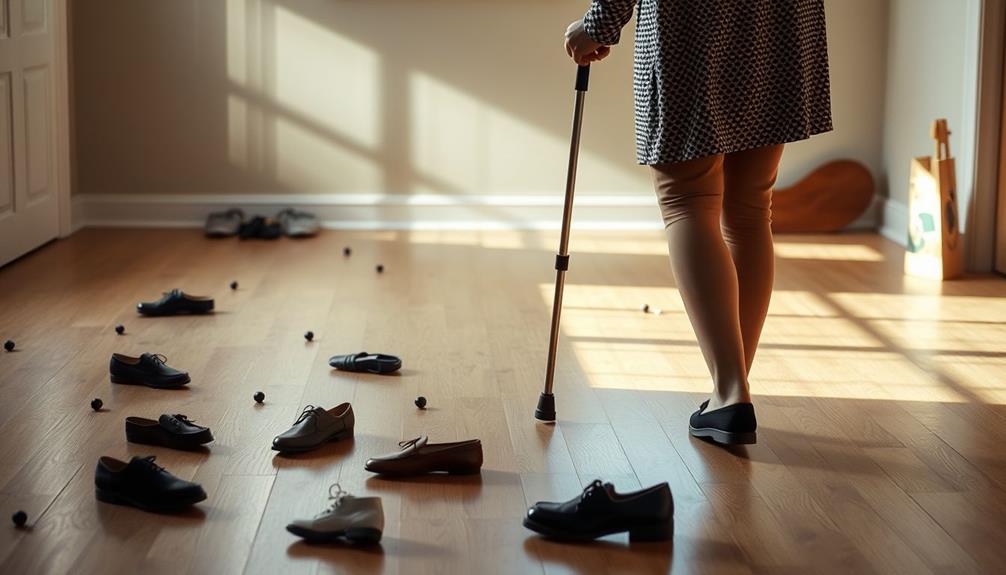
Recognizing the various factors that contribute to fall risk in individuals with Parkinson's disease is essential for maintaining safety and independence. Approximately 60% of people with Parkinson's experience falls each year, often due to balance impairments. Key risk factors include postural instability and freezing of gait, which can greatly increase the likelihood of future incidents.
Individuals with Parkinson's may also experience emotional dysregulation, similar to those with Borderline Personality Disorder, which can affect their overall stability and response to their environment. Cognitive impairments, such as deficits in executive function and difficulty with dual-tasking, can exacerbate fall risks by making it harder to navigate and respond to environmental challenges.
Additionally, orthostatic hypotension is common in Parkinson's disease, causing dizziness when standing up, which can lead to unsteadiness and falls, especially during changes from sitting to standing.
Motor symptoms also play a critical role. Shorter, slower, and shuffling steps disrupt your balance, leading to a higher incidence of falls. By identifying these fall risk factors—postural instability, freezing of gait, cognitive impairments, orthostatic hypotension, and motor symptoms—you can better understand your challenges and work toward mitigating them.
This awareness is the first step in preserving your mobility and ensuring your safety.
Effective Fall Prevention Strategies

To effectively prevent falls, you should focus on a combination of exercise, environmental modifications, and medication management.
Regular physical activity can strengthen your muscles and improve balance, while making changes in your home can reduce hazards.
Additionally, understanding the importance of managing behavioral issues in seniors can also enhance safety by addressing any cognitive or emotional challenges that may contribute to instability.
Moreover, managing your medications can help minimize dizziness, making it easier to stay steady on your feet.
Exercise and Physical Activity
Engaging in regular exercise is crucial for individuals with Parkinson's disease, as it greatly enhances muscle strength and improves balance. Incorporating structured physical activity into your routine can greatly reduce falls, with progressive resistance strength training recommended 2-3 times weekly for 20-60 minutes. Research shows that exercise programs can lower fall rates by about 35% in early to mid-stage Parkinson's.
Additionally, incorporating practices like yoga for back pain can help in improving flexibility and posture, further aiding balance.
Participating in well-designed, fully supervised exercise programs proves more effective than less structured options. Programs like PD-WEBB focus on balance and strengthening exercises, yielding considerable improvements in both physical performance and psychological health.
Multi-domain interventions, combining cognitive and motor tasks—such as dual-task activities or Tai Chi—also contribute to better falls prevention outcomes compared to standard physiotherapy.
Moreover, tailored exercise interventions specifically addressing freezing of gait can provide moderate positive effects, ensuring that your exercise routine meets your unique movement challenges.
Prioritizing physical activity not only helps improve balance but also promotes overall well-being, making it a crucial component of your fall prevention strategy. Stay active, and you'll be taking considerable steps toward maintaining mobility and reducing the risk of falls.
Environmental Modifications
Creating a safe environment is essential for preventing falls in individuals with Parkinson's disease. Environmental modifications can notably reduce the risk of falls by addressing common hazards within your home. Here are some effective strategies:
| Modification | Purpose | Benefits |
|---|---|---|
| Remove rugs and clutter | Reduce tripping hazards | Decreases risk of falls |
| Install grab bars | Provide support in bathrooms and stairs | Enhances stability during changes |
| Use proper footwear | Guarantee non-slip soles | Improves stability on various surfaces |
Improving home safety is vital. Bright lighting can enhance visibility, helping you navigate spaces without fear. Also, keeping frequently used items within easy reach minimizes unnecessary movements that could lead to falls. Don't forget to incorporate balance exercises into your routine; they can strengthen your stability and confidence.
Medication Management Strategies
Since managing medications effectively can greatly impact your stability, it's important to work closely with your healthcare provider to review and adjust your Parkinson's medications regularly.
Effective medication management can minimize side effects like dizziness and confusion, which increase the risk of falls in PD. Additionally, incorporating stress management techniques can further enhance your overall well-being and stability.
One significant aspect is monitoring blood pressure, particularly for orthostatic hypotension, which can cause lightheadedness when standing. This condition heightens your chances of falling.
Additionally, consider utilizing cholinesterase inhibitors if you have cognitive impairments, as they might offer protective effects against falls by addressing both motor and nonmotor risk factors.
Implementing a tailored medication management plan that includes timing and dosage adjustments can enhance your stability and reduce the frequency of freezing episodes, a common trigger for falls.
It's also important to educate yourself and your caregivers about potential medication side effects related to balance and coordination.
Responding to Falls
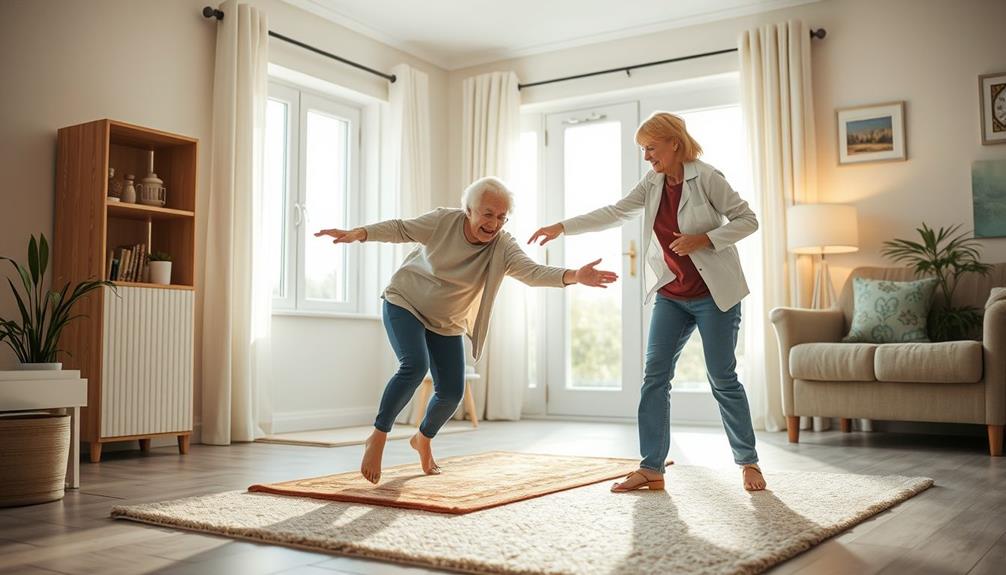
When you experience a fall, it's essential to stay calm and check for any injuries before trying to get up.
Understanding the emotional impact of such incidents can be important, as feelings of anxiety or fear may arise.
Use nearby furniture for support, and take your time to plan your movements carefully.
Immediate Actions After Falls
Falling can be a frightening experience, especially for those with Parkinson's disease. After a fall, it's essential to stay calm and assess for any injuries before trying to move. Rushing to get up can lead to further injuries.
Consider using essential oils for calming effects, as oils like lavender oil may help alleviate anxiety during this stressful time. Take your time to plan your movements carefully. Look for sturdy furniture or objects to provide support as you attempt to get back on your feet.
If you feel any pain or discomfort, don't hesitate to call for help or use a medical alert device. Remember, your safety is the priority. Assess your environment and remain aware of potential hazards that might've contributed to the fall. Identifying these risks can help you prevent future falls and improve your overall mobility.
Once you're up, it's wise to take a moment to gather yourself before continuing with your day. Reflect on what happened and consider if any adjustments to your environment or routine are needed to enhance your safety.
Long-term Recovery Strategies
After experiencing a fall, focusing on long-term recovery strategies is vital for regaining confidence and mobility. Start by staying calm and evaluating any injuries. Develop a plan for movements post-fall, using stable objects for support. Engaging in physical therapy can greatly improve recovery outcomes, addressing specific balance and movement issues related to Parkinson's disease.
Incorporating regular balance exercises into your routine is fundamental for fall prevention and enhancing stability. These exercises can reduce the likelihood of future falls, supporting your long-term recovery. Additionally, utilizing assistive devices, such as walkers, can provide the necessary support during recovery and boost your confidence in mobility.
Here's a helpful table to guide your long-term recovery strategies:
| Strategy | Description | Benefits |
|---|---|---|
| Physical Therapy | Tailored exercises to improve balance and strength | Enhances recovery outcomes |
| Balance Exercises | Regular practice of stability-focused movements | Reduces future fall risk |
| Assistive Devices | Use tools like walkers or canes | Increases confidence in mobility |
| Movement Plan | Strategic use of furniture for support | Aids safe recovery post-fall |
| Support Network | Engage with family or friends for assistance | Encourages emotional support and safety |
Tips for Safer Mobility
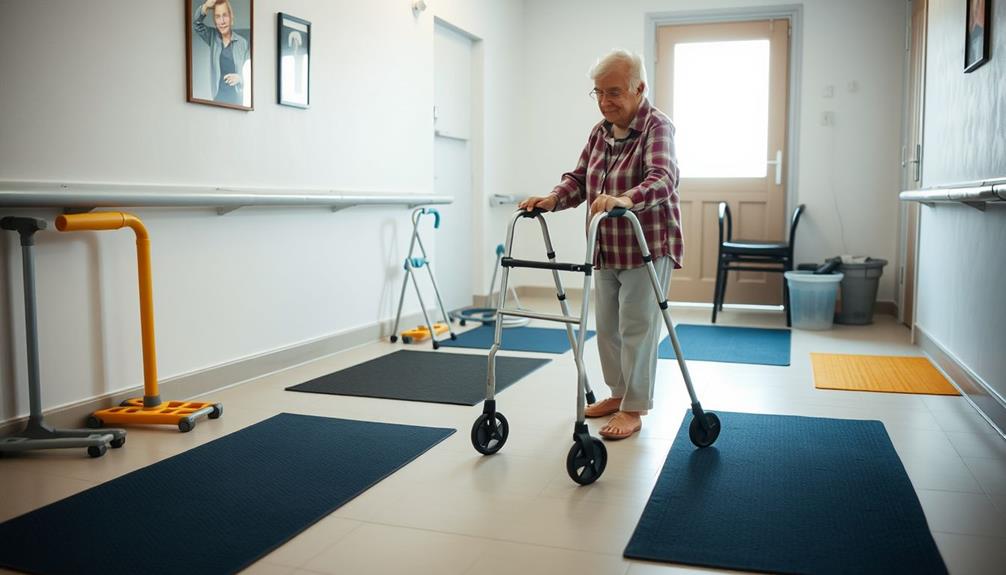
Maneuvering daily activities can feel intimidating for those with Parkinson's disease, but there are practical tips to help you stay mobile and safe.
Start by taking your time during changes, like sitting or standing, which can greatly enhance your stability and prevent falls. Widening your stance and taking larger steps while walking will improve your balance and reduce the chances of tripping.
Additionally, understanding the key domains of development can provide insight into how cognitive and emotional factors may influence your mobility and confidence.
Keep frequently used items within easy reach to minimize unnecessary movements. This simple strategy can lower the likelihood of falls and keep you organized.
Additionally, limit distractions by keeping your hands free and avoiding multitasking while walking; this focus will help you maintain better stability.
Consider utilizing fall detection systems, which provide an added layer of safety for individuals at risk due to the symptoms of Parkinson's disease.
Finally, don't hesitate to consult a physical therapist for personalized strategies to reduce the risks of falls.
By implementing these tips, you can enhance your mobility and feel more confident managing your environment.
Role of Exercise in Balance

Exercise plays an essential role in enhancing balance for individuals with Parkinson's disease. Regular, structured exercise, particularly balance and strength training, can greatly improve your physical performance and reduce the risk of falls. Moreover, engaging in consistent physical activity can help maintain mobility and flexibility, which are often compromised in individuals with this condition. Exercise for Parkinson’s disease does not just benefit physical health; it can also improve mental well-being by reducing symptoms such as depression and anxiety. Incorporating targeted exercise programs into daily routines can make a significant difference in overall quality of life for those living with Parkinson’s.
Research shows that engaging in an exercise program can lower fall rates by about 35%, especially for those in the early to mid-stages of the disease. Additionally, maintaining a budget for fitness-related expenses can help guarantee consistent participation in exercise programs, which is vital for long-term health budgeting for fitness.
To help you understand the benefits of exercise for balance, consider these key points:
- Strength training targets major muscle groups, boosting your stability and mobility.
- Balance exercises enhance your body awareness, helping you maintain control.
- Incorporating dual-task activities into your routine can yield better fall prevention results.
- Progressive resistance training, done 2-3 times weekly, is highly effective.
- Regular exercise can lead to a noticeable reduction in falls, as seen in various studies.
Importance of Medication Review

Managing your medication is essential when living with Parkinson's disease, as some treatments can inadvertently lead to side effects that compromise your balance. Regular medication reviews are important for identifying any drugs that may increase your risk of falls, such as those causing dizziness, confusion, or sedation.
Additionally, understanding the importance of a transparent fee structure in precious metal investments can help guarantee that your financial health is also a priority, allowing you to focus on your physical well-being. By evaluating your antiparkinsonian medications, healthcare providers can make timely adjustments to minimize these risks and enhance your overall stability.
Collaborating with neurologists and pharmacists during these reviews helps confirm that potential drug interactions and side effects are addressed. This teamwork contributes greatly to safer movement and effective fall prevention strategies.
Optimizing your medication regimen can't only improve your motor symptoms but also alleviate non-motor issues, ultimately boosting your quality of life.
Additionally, ongoing monitoring and adjustments based on your feedback and health changes can lead to better adherence and outcomes. By actively participating in your medication review process, you can maintain your mobility while minimizing the likelihood of falls.
Utilizing Assistive Devices
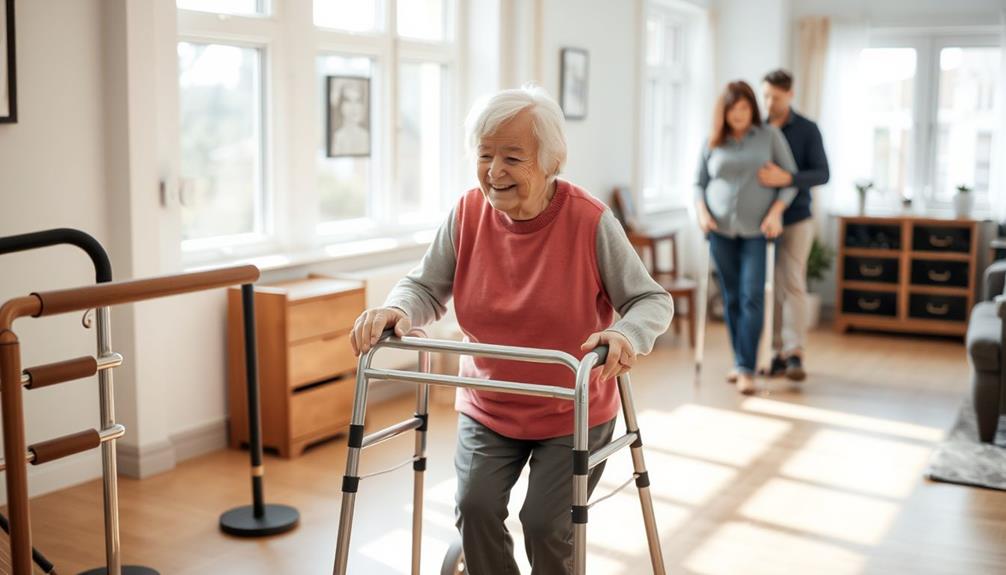
Finding the right balance in your daily life with Parkinson's disease often involves more than just medication management; incorporating assistive devices can play a vital role in maintaining your stability and independence.
These devices, like walkers and canes, enhance your mobility and greatly reduce fall risk during daily activities. Regular assessments and adjustments to your care plan, similar to the importance of routine health checks for pets, can help guarantee that your needs are met effectively routine health checks.
When considering assistive devices, here are a few options that might work for you:
- Walkers: Preferred for their broader base of support, they're great for preventing additional imbalance.
- U-step walkers: Specifically designed for Parkinson's, they feature advanced braking systems for better maneuverability.
- Canes: While not as stable as walkers, they can still provide support if used correctly.
- Grab bars: Installing these in key areas helps you get up safely from chairs or the bathroom.
- Mobility scooters: For longer distances, they can help maintain your independence.
Don't forget that proper training and assessment by healthcare professionals are essential.
Utilizing assistive devices doesn't worsen your balance issues; instead, they support your independence and enhance your quality of life.
Frequently Asked Questions
What Are the Signs That Parkinson's Is Getting Worse?
You might notice increased rigidity, slower movements, and more frequent freezing episodes. Cognitive challenges can intensify, affecting your memory and decision-making. Changes in medication response could also signal that the condition's worsening.
How Do You Improve Balance in Parkinson's Patients?
Like mastering a dance, you can enhance your balance through regular strength training, tai chi, and dual-task exercises. Incorporate visual cues and seek personalized therapy to navigate your path more confidently and steadily.
What Stage of Parkinson's Affects Balance?
Balance typically starts to decline in the middle to later stages of a condition. You might notice increased challenges as symptoms progress, affecting your stability and increasing your risk of falls during daily activities.
What Helps Parkinson's Loss of Balance?
To improve balance, you can engage in strength training, practice stability exercises, and use visual or auditory cues during movement. Staying hydrated and participating in tailored physical therapy can also greatly enhance your stability and prevent falls.
Conclusion
Just like a tightrope walker mastering their balance, you're maneuvering the challenges of Parkinson's. By understanding the risks and employing effective strategies, you can create a safety net beneath you. Embrace the support of exercise, medications, and assistive devices, transforming your journey into a graceful dance rather than a precarious stroll. Remember, every step you take is a demonstration of your strength; with awareness and preparation, you can turn potential falls into a powerful stride forward.
